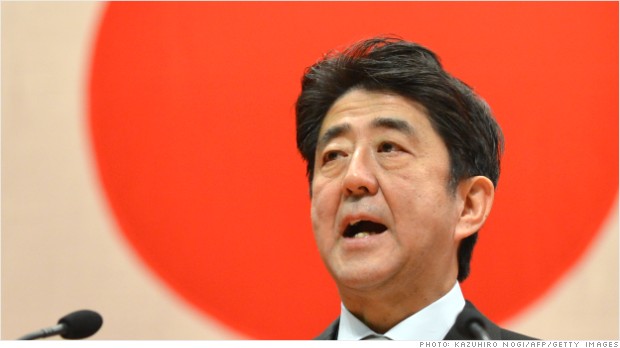The recent kick-start of the Japanese economy has the economic and political circles buzzing over “Abenomics”. Shinzo Abe’s drastic economic strategy, which he called a “three-arrowed booster plan,” immediately sparked a global interest that shows no signs of abating.
What’s in the Quiver?
Prime Minister Abe drew the analogy from an old Japanese proverb, which teaches that while a single arrow might be weak, three arrows cannot be broken. He presented three reforms that are decisive, controversial, and quite risky.
First Arrow: Aggressive Monetary Easing.
And he means aggressive. In order to pump money into the economy rapidly, the Prime Minister and the governor of the Bank of Japan, Haruhiko Kuroda, decided to double the country’s monetary base at a rate of ¥60-70 trillion (USD 600-700 billion) per year. The central bank is also doubling its purchases of sovereign bonds over two years, which will significantly increase the money supply. The central bank has set an inflation target of 2% per annum and is committed to reaching this goal, even if it means extending the monetary easing.
[captionpix align=”right” theme=”elegant” width=”300″ imgsrc=”http://resources3.news.com.au/images/2013/05/08/1226637/893823-130509-b-japan.jpg” captiontext=””]
Both Abe and Kuroda’s goal, along with almost every other Japanese politician over the last two decades, is to bring the country’s economy out of its long trend of deflation. The idea is to increase the money supply enough for the yen to lose some real value and spur inflation. This might seem counterintuitive, since high inflation is something most countries go through great measures to avoid, but Japan’s economy is quite resilient to inflation. It has been in a deflationary slump for the greater part of the last two decades and, while investors are very wary of high inflation, they avoid sustained deflation like the plague. Deflation is an indicator of an unhealthy economy with little growth prospects, signals the risk of a recession turning into a deflationary spiral, and increases the real value of debt. For a country that faces a gross debt close to 300% of its GDP, deflation is undesirable to say the least.
In the few months since Abe let loose the first arrow, the yen fell in exchange markets, making it more competitive and increasing exports, and causing the stock market to rise. The Nikkei 225, the primary index, has risen 66% since just before last year’s election, even if it remains a third under its 1991 level. However, some problems and instabilities have arisen. They led analysts to question the sustainability of the policy and point out societal factors that were not considered in Abe’s economic strategy.
Second Arrow: Fiscal Stimulus
In a very Keynesian move, Abe increased government spending by an extra ¥10.3 trillion (about US $100 billion), with around ¥3.8 trillion going to disaster prevention and reconstruction, and ¥3.1 trillion dedicated to invigorating private investment. Through the supplementary deficit-financed expenditure, he expects to “lift the economy by 2% and create 600,000 jobs”.
This one-time expenditure announced in January was Abe’s first push to bring Japan out of its third recession in five years, but it might be negated by the recent reforms in fiscal policy. Last week, the Japanese government approved a medium-term fiscal plan that would trim ¥17 trillion over the next two years while avoiding any new debt issuance.
This is a radical attempt to consolidate the fiscal budget and tackle rising debt. However the details were few as international pressure to restore Japan’s fiscal health grows. The Japanese government hopes to prove their “eagerness to balance the budget” at the G20 summit by combining the cuts with a proposed consumer tax doubling by 2015.
The question now is whether the initial fiscal push and the continued monetary easing strengthened the economy enough to withstand both the fiscal slashes and the reduction in consumption that the tax hike will cause. If not, Abe will have wasted his first two arrows and trillions of yen.
Third Arrow: Growth Strategy
The third arrow consists of boosting both investment and private consumption. This is by far the most vague, tricky and important aspect of Abenomics. The long-term success of the Prime Minister’s reforms depends on making the economy’s growth sustainable. The government cannot print money indefinitely and it certainly cannot keep funding fiscal expenditure from an out-of-control deficit. So, while the Prime Minister insists that the three arrows are being shot at the same time, in reality, the third depends on the success of the first two. Investors need positive economic indicators such as curbed deflation, good export prospects, and strong stock indexes to make a commitment. At the same time, consumers need a measure of confidence in the economy in order to feel comfortable switching from saving to spending. The first two policies are designed as only temporary boosters, while investment and consumption are the engines that will drive the economy.
The government has taken significant steps to encourage investment. Japan has entered negotiations for the Trans-Pacific Partnership; Mr. Abe has passed a fiscal plan to tackle the worrying debt; and the government assembled several reform committees that included the Industrial Competitiveness Council, economists, and private-sector businessmen to help structure a growth strategy.
However, his arrow may have fallen short. Many critics insist that the Prime Minister did not tackle the last part of his ‘Abenomics’ plan with as much zeal as the first two. They maintain that Abe, concerned about the July elections, was not committed to the reforms necessary to inspire action from investors and businesses, especially in the labour sector. In Japan, it is virtually impossible to fire or lay off a worker unless he has broken the law dramatically. To cut jobs, firms must meet a number of conditions such as consecutive years of losses. These policies make it difficult and costly for Japanese companies to adapt to a changing economic landscape. They also make expanding into Japan unattractive; firms do not want to be trapped into unnecessary labour costs by inflexible legislation.
Just off the Mark
Abenomics initially seemed a very successful strategy that strengthened stock markets and created a Yen that promised rising exports. However, Abe’s failure to commit to significant long-term reforms puts his whole economic approach in danger. Unless Japan really hits the target with its third arrow and implements the necessary incentives for investment, the economy will crash again the instant the fiscal cuts come into effect. Without policies that make growth sustainable, the boom the Japanese economy has seen the past couple of months will die down with nothing to show but an even greater sovereign debt.




